In the diverse avian tapestry of North America, one bird stands out with such extraordinary brilliance that it seems to have been dipped in neon paint. The Western Tanager, with its flame-colored head and vibrant yellow body, creates a spectacular visual display that has captivated birdwatchers and nature enthusiasts for generations. This naturally neon songbird doesn’t achieve its remarkable coloration through artificial means but through a fascinating biological process that makes it one of the most visually striking species on the continent. As we explore the world of this remarkable creature, we’ll discover not just its vibrant appearance, but also its behaviors, habitat preferences, and the special place it holds in North American ecology.
The Western Tanager: North America’s Living Flame
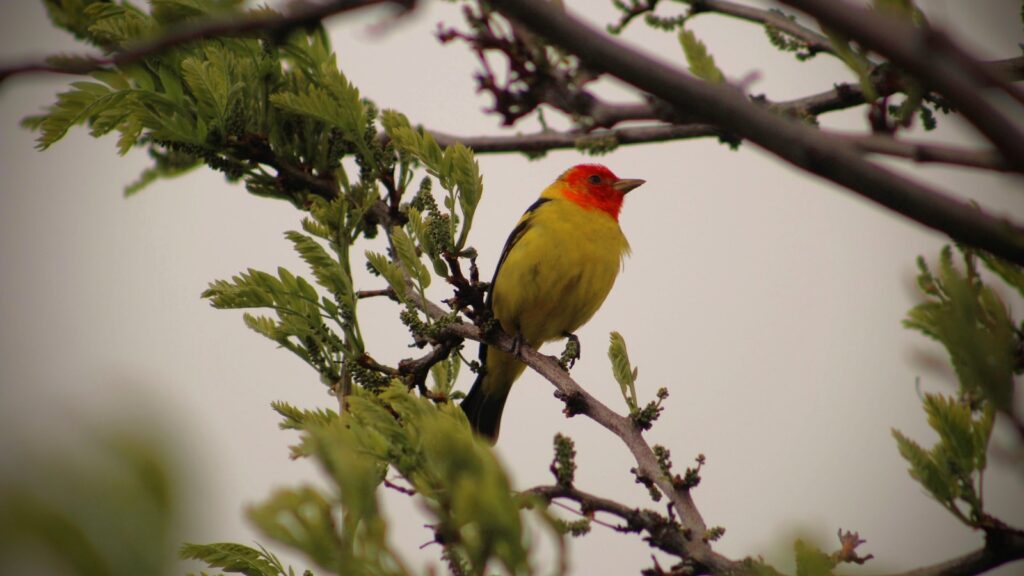
The Western Tanager (Piranga ludoviciana) stands as the brightest naturally occurring bird in North America, sporting a remarkable combination of fiery red-orange head, brilliant yellow body, and contrasting black wings and tail. Unlike many colorful birds that require special dietary pigments to maintain their hues, the Western Tanager’s red pigmentation comes from a rare compound called rhodoxanthin, which is unusually scarce in the natural world. This medium-sized songbird, measuring about 7 inches in length, creates such a startling visual impact against green foliage that early naturalists often described them as “flying flames” moving through the forest canopy. Their extraordinary appearance seems almost artificial in its intensity, yet it’s entirely natural—a masterpiece of evolutionary adaptation and natural selection.
The Chemistry Behind the Colors
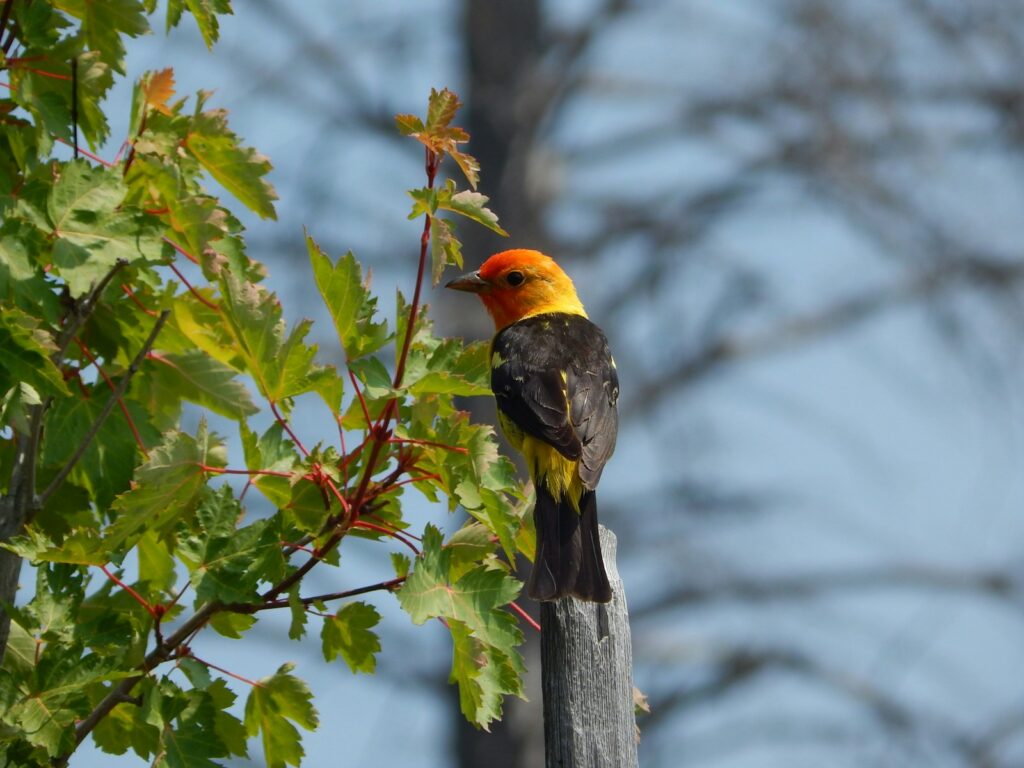
The Western Tanager’s striking coloration involves a fascinating biochemical story that sets it apart from most other colorful birds in North America. While its yellow pigmentation comes from carotenoids that the bird obtains through its diet, the vivid red-orange of its head comes from rhodoxanthin, a rare pigment that scientists believe the tanager cannot produce or extract from its typical food sources. Instead, researchers theorize that the bird obtains this pigment by consuming specific insects that have themselves fed on plants containing rhodoxanthin, making the tanager’s coloration the result of a complex ecological chain. This unusual pigment acquisition explains why captive tanagers often lose their vibrant head coloration when they cannot access their natural diet. The chemical process represents one of the most intriguing examples of how diet directly influences avian appearance in the wild.
Range and Migration Patterns
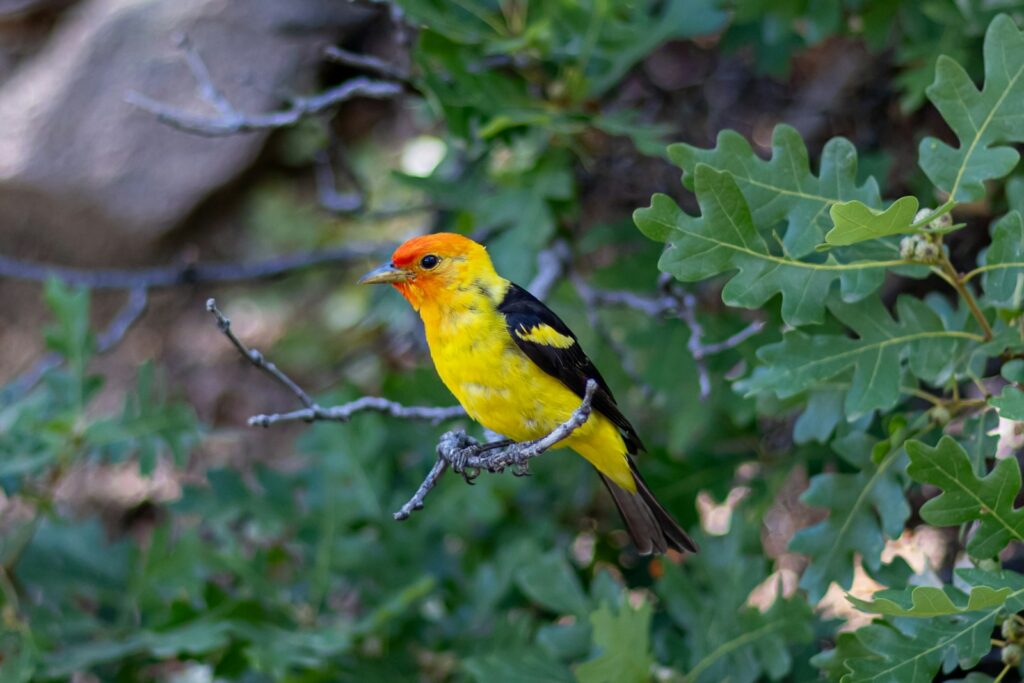
The Western Tanager occupies a vast range across western North America, breeding in coniferous and mixed forests from Alaska to northern Mexico. During summer months, these brilliant birds can be found as far north as the Yukon and as far east as western Nebraska, establishing territories in montane forests and woodlands. Come fall, they embark on an impressive migration journey to their wintering grounds in Mexico and Central America, traveling up to 2,000 miles between seasonal habitats. During migration, these normally forest-dwelling birds may appear briefly in unexpected locations, including suburban gardens and urban parks, offering fleeting glimpses of their spectacular coloration to delighted observers far from their typical habitat. The contrast between their northern breeding grounds and tropical wintering areas represents one of the more dramatic seasonal shifts among North American songbirds.
Diet and Feeding Behavior
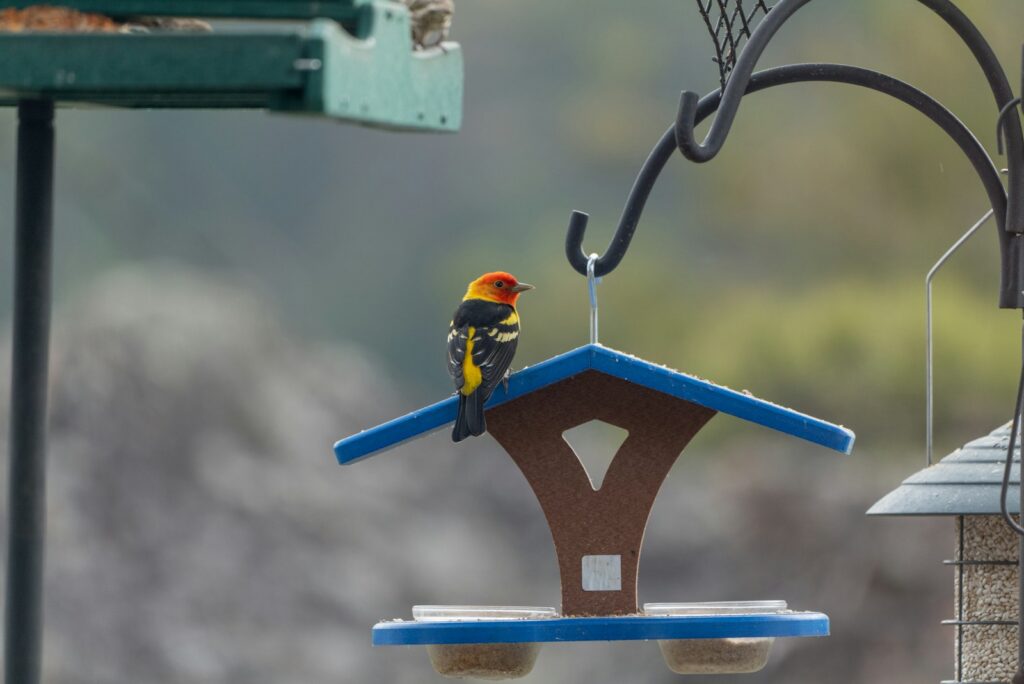
Western Tanagers maintain a diverse diet that shifts seasonally and plays a crucial role in their distinctive appearance. During summer breeding season, they primarily consume insects, including wasps, bees, beetles, grasshoppers, and caterpillars, which they glean from foliage or occasionally catch in mid-air with remarkable agility. This insectivorous diet during breeding provides both essential proteins for reproduction and the specialized compounds that contribute to their vibrant plumage. In winter and during migration, they supplement with fruits and berries, showing particular fondness for elderberries, mulberries, and wild cherries when available. Researchers have observed that their feeding behavior is methodical and deliberate, with birds systematically searching through foliage in the middle and upper canopy, revealing a level of hunting sophistication that belies their flashy appearance.
Courtship and Breeding Behaviors
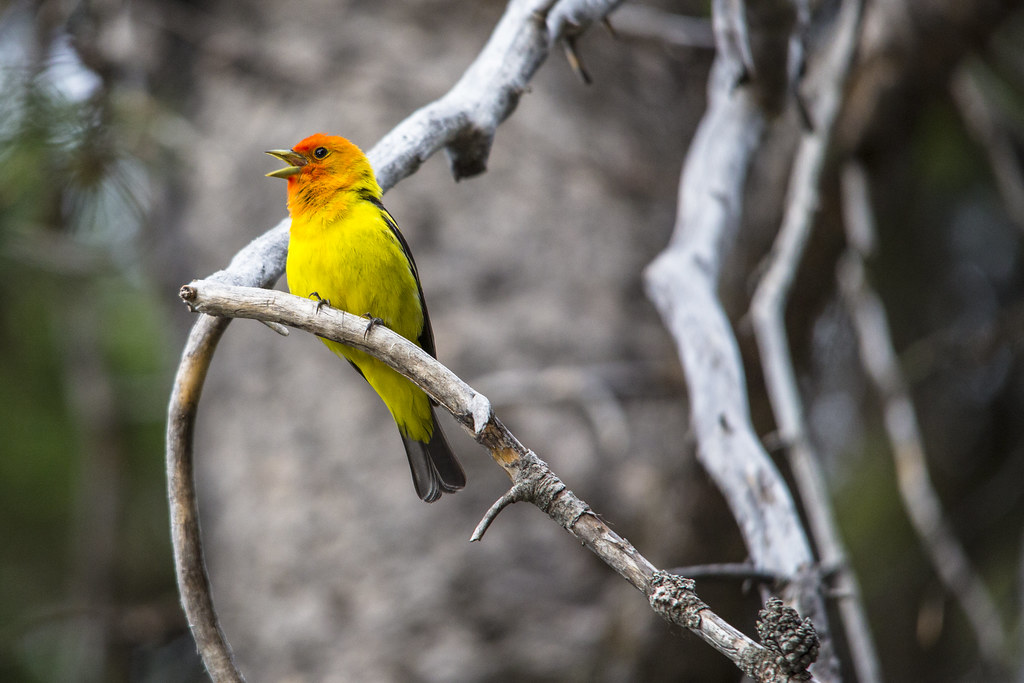
The Western Tanager’s breeding season transforms the already brilliant male into a territorial singing machine, establishing and defending nesting territories with persistent vocalizations and dramatic aerial displays. Males arrive at breeding grounds ahead of females and immediately begin advertising their presence with a distinctive song described as a hoarse, robin-like warble interspersed with sharp “pit-er-ick” calls that carry through the forest. Courtship involves elaborate displays where the male puffs his feathers to maximize the visual impact of his colorful plumage, performs short flight displays, and offers food gifts to potential mates. After pair formation, the female builds a relatively loose cup-shaped nest typically placed on a horizontal branch of a conifer, usually 15-40 feet above ground and often well-concealed despite the male’s bright coloration. This balance between conspicuous courtship and discreet nesting represents an evolutionary compromise between attraction and protection.
The Female Western Tanager: Subtle Beauty
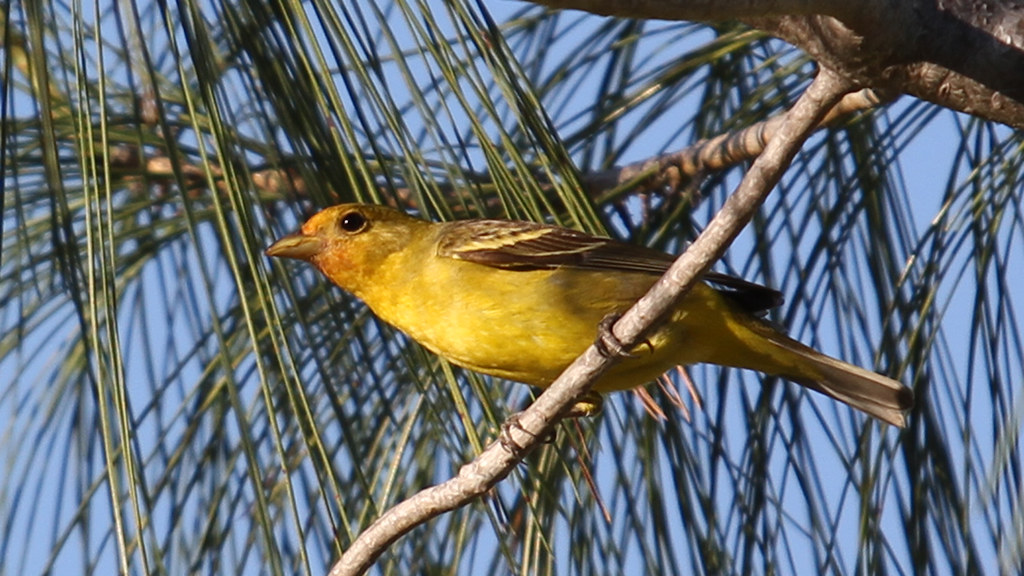
While the male Western Tanager receives most attention for its dramatic coloration, the female displays her own subtle elegance that deserves appreciation. Female tanagers wear a more subdued palette of olive-green upper parts and yellowish underparts, with dusky wings showing two distinct wing bars. This muted coloration serves a crucial evolutionary purpose, providing effective camouflage during the vulnerable nesting period when predator avoidance is essential for reproductive success. Despite lacking the male’s fiery head, female tanagers still rank among the more colorful female songbirds in North America, particularly when sunlight illuminates their yellowish underparts against forest foliage. Their more subtle appearance represents not an absence of color but rather an adaptive specialization that balances visibility within the species with concealment from potential threats.
Conservation Status and Challenges

The Western Tanager currently maintains a conservation status of “Least Concern” according to the International Union for Conservation of Nature, with stable population trends across much of its range. However, like many migratory songbirds, the species faces increasing challenges related to habitat loss in both breeding and wintering grounds. Logging operations in northern coniferous forests can reduce suitable breeding habitat, while deforestation in Central American wintering areas creates bottlenecks in the species’ annual cycle. Climate change poses additional threats, potentially disrupting the synchronization between the tanagers’ migration timing and the emergence of their insect prey, a phenomenon scientists call “phenological mismatch.” Conservation efforts focusing on protecting mature forest corridors along the entire migratory pathway provide the most promising approach to ensuring this brilliant bird’s future in North American ecosystems.
Historical Significance and Cultural Connections

The Western Tanager has captivated human imagination since long before formal scientific description, featuring prominently in the traditions of several indigenous peoples throughout its range. Among certain Native American tribes of the Pacific Northwest, the tanager’s fiery appearance associated it with the sun and transformation myths, while its seasonal appearance marked important calendar events related to fishing and gathering activities. The bird was first scientifically described by Alexander Wilson in 1811, who named it Tanagra ludoviciana, though it was later moved to the genus Piranga. Early European settlers and explorers frequently mentioned the bird in journals and correspondence, often expressing astonishment at its unexpected brilliance in the otherwise subdued palette of western forests. The tanager’s image has appeared on numerous stamps, conservation materials, and state wildlife publications, becoming an iconic representative of western forest biodiversity.
Photography Challenges: Capturing the Glow
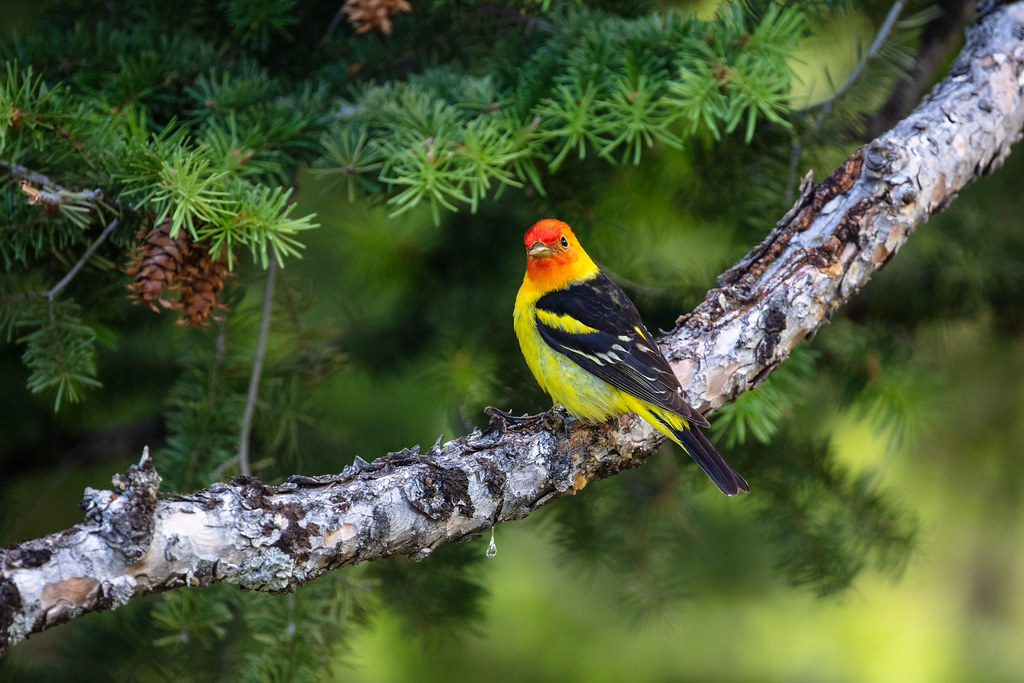
Wildlife photographers face unique challenges when attempting to document the Western Tanager’s remarkable coloration, as conventional photography often fails to accurately capture the bird’s natural radiance. The tanager’s red-orange head contains pigments that interact with light in ways digital sensors struggle to reproduce accurately, frequently appearing either oversaturated or understated depending on lighting conditions and camera settings. Experienced bird photographers recommend using early morning or late afternoon light with slight underexposure to best represent the true visual impact of the bird’s appearance. Additionally, the tanager’s preference for the forest canopy often places it in dappled light or against bright sky, creating exposure challenges that require bracketing techniques or specialized post-processing. Despite these technical hurdles, successfully photographing a male Western Tanager in full breeding plumage represents a prized achievement among wildlife photographers and often produces images that viewers assume must be digitally enhanced, when in fact they merely approximate the bird’s natural brilliance.
Birdwatching Tips: Finding the Flame

Birdwatchers hoping to spot the Western Tanager should focus their efforts during late spring migration and early summer when males are most conspicuous due to their breeding behavior and vocalizations. The best viewing opportunities typically occur in mature coniferous or mixed forests with open understories, particularly near water sources where tanagers often gather to drink and bathe. Rather than looking for movement directly, experienced birders recommend listening for the distinctive “pit-er-ick” call notes and then scanning middle to upper canopy levels where these birds typically forage. During migration periods, focusing on flowering or fruiting trees can yield sightings as tanagers replenish energy reserves during their long journey. For urban wildlife enthusiasts, installing bird baths and native fruit-bearing plants like elderberry, serviceberry, or wild cherry can occasionally attract migrating tanagers to suburban gardens, though such visits are typically brief and unpredictable.
Comparisons with Other Colorful North American Birds
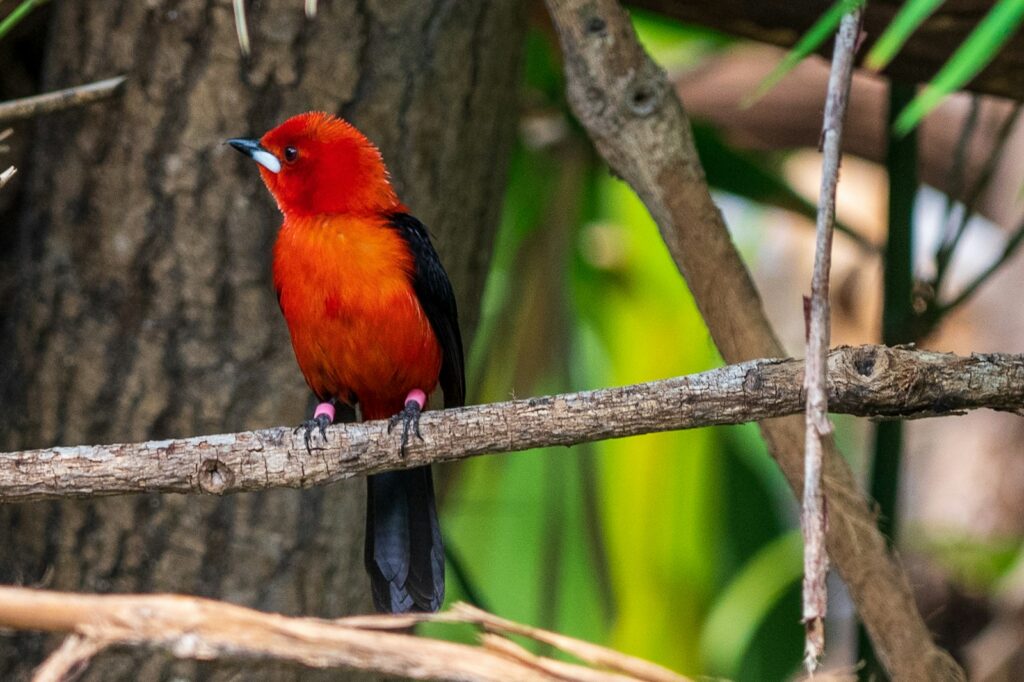
While North America hosts several brilliantly colored bird species, the Western Tanager stands apart in terms of color intensity and the biochemical uniqueness of its pigmentation. The Scarlet Tanager, despite its name, achieves its red coloration through more common carotenoid pigments rather than the rare rhodoxanthin that gives the Western Tanager its distinctive hue. The Painted Bunting, often considered America’s most colorful songbird with its rainbow palette, creates its effect through a patchwork of different colors rather than the Western Tanager’s intense focused brilliance. Unlike many colorful birds that molt into duller winter plumage, male Western Tanagers retain much of their vivid coloration year-round, though it may appear somewhat muted outside breeding season. The Baltimore Oriole, Northern Cardinal, and Vermilion Flycatcher all display impressive red or orange plumage, but spectrophotometric analysis confirms that the Western Tanager’s head feathers reflect light at wavelengths that create a uniquely intense visual impact unmatched by other native species.
The Western Tanager in a Changing Climate

Climate researchers and ornithologists have identified the Western Tanager as a potential indicator species for monitoring the effects of climate change on western forest ecosystems. Long-term studies tracking the tanager’s migration timing show that spring arrivals have advanced by approximately 2.5 days per decade since the 1970s, correlating with warming temperatures across their breeding range. This shift raises concerns about potential misalignment with prey availability, as insect emergence may not be changing at the same rate as the birds’ arrival timing. Range modeling suggests that the Western Tanager’s breeding distribution may shift northward and to higher elevations as temperatures continue to rise, potentially reducing available habitat in the southwestern portions of its current range. Citizen science projects like the North American Breeding Bird Survey and eBird have proven invaluable for tracking these changes, with thousands of volunteer observers contributing data that helps scientists understand how this iconic species is responding to our rapidly changing climate.
The Evolutionary Puzzle: Why So Bright?
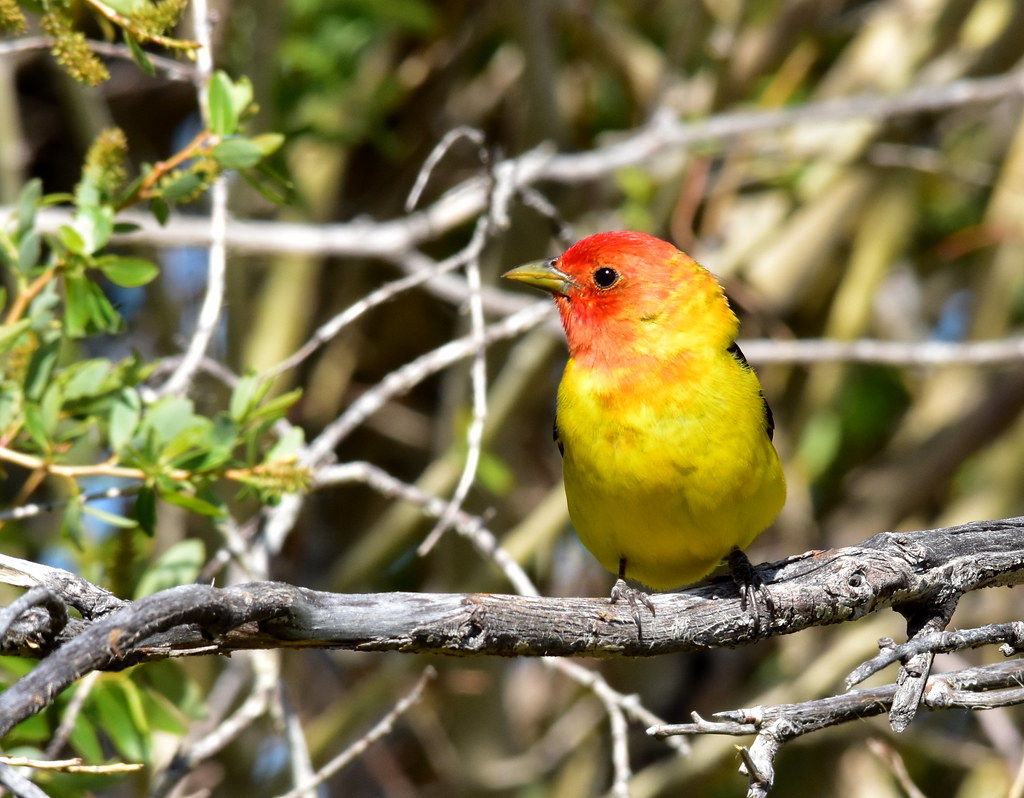
The extreme brilliance of the male Western Tanager presents an evolutionary paradox that continues to intrigue ornithologists and evolutionary biologists. While sexual selection clearly plays a role, with females potentially favoring brighter males as indicators of genetic fitness and foraging ability, such conspicuous coloration would seemingly increase predation risk. Researchers theorize that several factors may explain this apparent contradiction, including the tanager’s preference for high canopy habitats where avian predators approach from below against bright sky, making the tanager’s ventral coloration less conspicuous than it appears to ground-based human observers. Additionally, studies suggest that the specific wavelengths reflected by the tanager’s plumage may be less visible to certain predator visual systems than to human or conspecific eyes. The energetic cost of maintaining such bright coloration through specialized diets likely serves as an honest signal of male quality that outweighs predation risks, representing a finely tuned evolutionary balance between attraction and survival that has developed over millions of years.
Conclusion
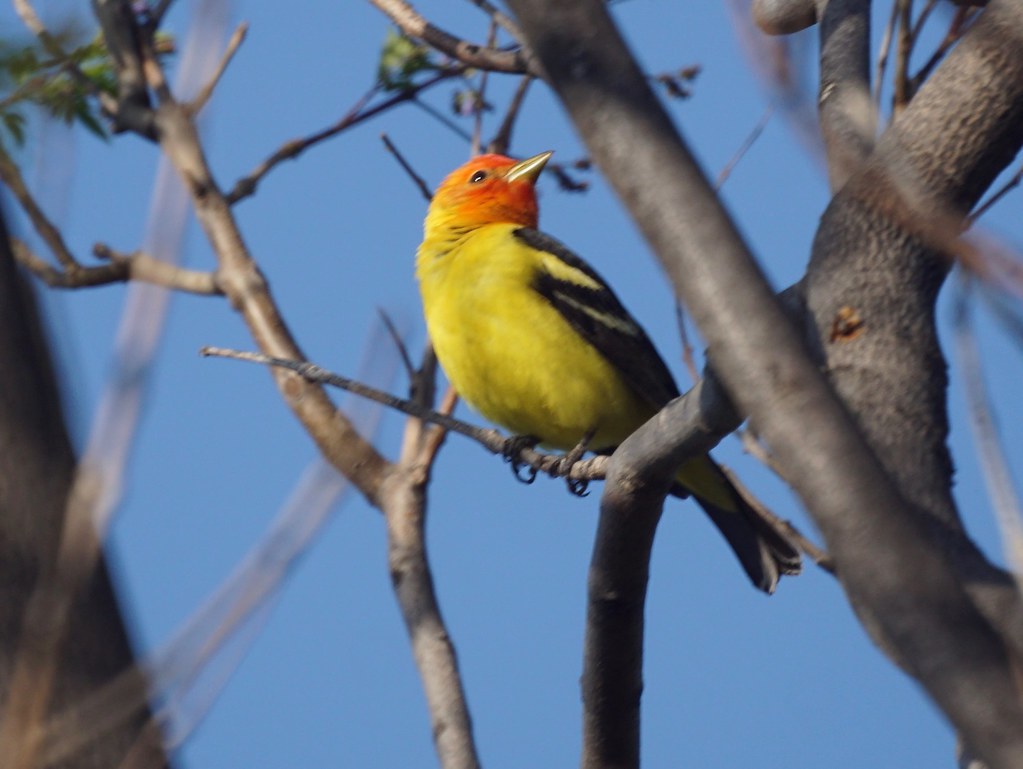
The Western Tanager stands as nature’s masterpiece among North American birds, a living embodiment of natural brilliance that continues to astonish observers with its seemingly artificial neon display. From the unique biochemistry that creates its vibrant colors to its impressive migratory journeys spanning thousands of miles, this remarkable songbird represents far more than just a pretty face in the forest canopy. As climate change and habitat loss pose increasing challenges to bird populations worldwide, the Western Tanager’s story reminds us of the complex ecological relationships that sustain biodiversity and the importance of conservation efforts that protect these natural wonders. The next time you glimpse a flame-like flash among the treetops of a western forest, take a moment to appreciate not just the beauty of the Western Tanager, but the intricate natural processes that have created and sustained North America’s naturally neon bird.
